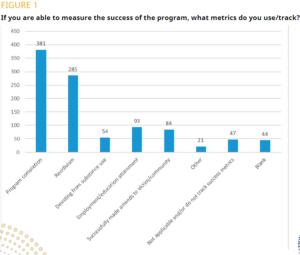Success Metrics for Prosecutor-Led Diversion
Thematic Report
Download PDFKey Statistics
Starting in 2021, the National District Attorneys Association (NDAA) and the Urban Institute surveyed prosecutors’ offices across the country about any prosecutor-led diversion programs they currently run. The results of the survey are available at diversion.ndaa.org and displayed as a national map of prosecutor-led diversion programs.
As of October 31, 2023, responding offices had submitted information on 497 programs. Prosecutors reported that they measure the success of their diversion programs in a variety of ways. More than three-fourths (381) of programs reported using program completion as a success metric. Recidivism was used to measure success in 57 percent of programs. Other metrics were used much less frequently, with 19 percent of programs using employment or educational attainment as a success metric and 17 percent of programs measuring success as successfully making amends to the victim or community.

Background Information
Measuring the results of a diversion program is important to several audiences for many reasons. The leader of the office, the members of staff, partners and stakeholders, community, funders, and the field all can use information about how the program is doing, whether efforts to improve the program are working, share information to constituents and funders about the success of the program, and evaluate if the program is cost effective and is worthy of increased funding and support.
While the advantages of collecting and measuring how a diversion program is operating may be well known, one of the obstacles that stand in the way of offices doing more is the availability and ability to collect the data needed to measure outcomes. Among the programs that submitted information to the Mapping Prosecutor-led Diversion website, the majority—82 percent—reported the ability to collect some data. Just over half of programs listed relied on information generated by the prosecutor’s office. Further, 38 percent collected information from law enforcement or service providers. Lastly, 9 percent collected data from surveys with participants, victims, or the community.
Another challenge in interpreting success metrics is understanding the context in which the diversion program is operating. For instance, some offices make most cases eligible for diversion, while others have very specific and targeted criteria. Among the programs that submitted information to the Mapping Prosecutor-led Diversion website, most reported that only a small percentage of their total cases—usually under 10 percent—are referred to the diversion program. Further, knowing how many eligible cases are actually referred to diversion is important in understanding a program’s impact. Among programs that also reported what percentage of cases within a relevant type of case were diverted to the program, the results varied dramatically, ranging from very small numbers up to 100 percent.
There have been evaluations that review prosecutor diversion success metrics, including a National Institute of Justice Multisite Evaluation conducted in 2018 and a Loyola University 2015 evaluation of a Cook County program. The NIJ evaluation measured outcomes by reporting conviction and jail sentences for the current offense as well as future arrests. It also reviewed cost effectiveness. The Loyola study reported successful completion of the diversion as well as future arrests. Similarly, respondents to the diversion.ndaa.org repository indicated most often reporting successful completions and recidivism results.
Recommendations
Prosecutors should consider investing thought, time and resources into identifying and collecting data to track success metrics of a diversion program.
Some lessons learned from the survey as well as people interviewed as part of this project include:
- Ensure your office can collect information on program completion and recidivism measures, but also think broadly about what success looks like for program participants from a more holistic perspective. Consider tracking other metrics such as desistance from substance use, employment or educational attainment, and successfully making amends to victims or the community more broadly.
- Identify what information is needed to measure the success of the program, and the resources required to gather that information. This could include improved data management systems, surveys with participants, staff resources/more staff (e.g., data analysts, social workers, diversion manager, admin staff), better sharing among agencies, including other law enforcement, mental health, social services/health, education, employment, and better ways of tracking and measuring recidivism.
- Consistently track and analyze the data routinely so that you know how to adapt quickly to changing trends, consult with partners, and advocate for more funding for your program.
- Consider finding and working with independent evaluation and research partners who can provide a research-informed perspective on which metrics to track. Formal evaluations can also lend credibility to findings about prosecutor-led diversion programs.
- Connect with your community to share information about your program’s success. This can help build awareness about your program, trust with the community, and connections to community-led organizations who may be valuable partners.